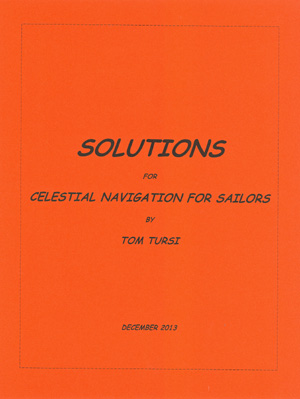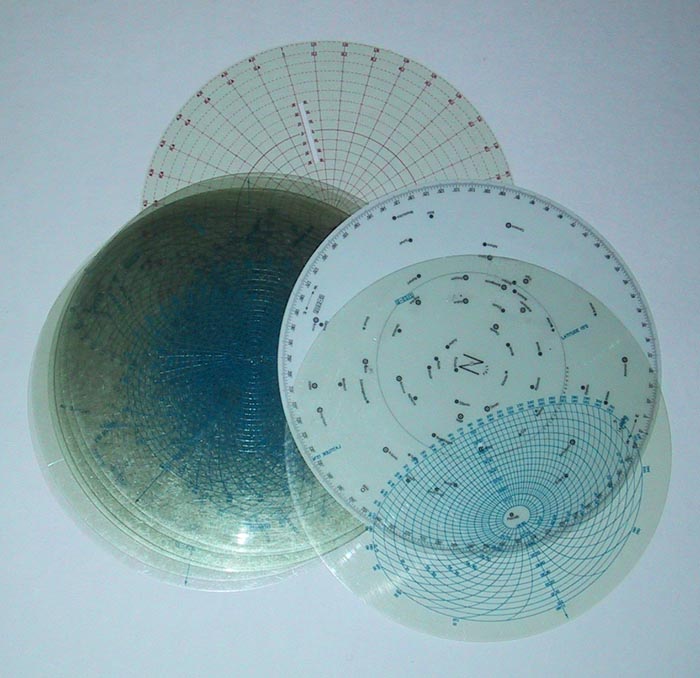Celestial Navigation
ASA107 Course Materials

|
 |
 |
|
|
1.
Celestial Navigation for Sailors text; 270 pages;
Sept 2019 edition. |
2.
Solutions for Celestial Navigation for Sailors
workbook; 144 pages |
3. Star Finder 2102D Circular Slide Rule. Purchase item 23 |
|

|
|
 |
|
|
4.
NGA 925 Position Plotting Sheet; 35 x 45 inch
chart. |
5. Homework Plotting Sheets. Download PDF |
6.
HO229 Sight Reduction Tables, Volume 3; purchase from Amazon
or others. |
|
 |
|||
|
7. Almanac
Extracts for Exam Download PDF |
Instructor Teaching Guide
by Tom Tursi
The
ASA107 Celestial Navigation Course uses the items shown above. These
materials should be provided to students in advance of class to
permit study prior to coming to class. Ask students to read at least
Chapter 1 in the Celestial Navigation for Sailors text, and to
attempt to do the Chapter 1 homework prior to the first class day.
Students will need one copy of the NGA 925 position plotting sheet during class to complete homework assignments and a second copy when taking the ASA107 exam. The Homework Plotting Sheets shown above can be used for some of the homework assignments, but cannot be used for the exam.
Appendix L provides answers to all homework questions in the Celestial Navigation for Sailors text, and the Solutions to Celestial Navigation for Sailors workbook gives step-by-step solutions to all of these questions.
For
classroom instruction, I suggest that projection images be prepared
from the figures in the textbook. It's also helpful to hand-draw some
images on a flip chart during class to help students follow the more
difficult procedures.
I suggest that instructors require students to hand in homework assignments for review and coaching. Otherwise, some students fall behind and hesitate to ask questions.
Also,
show in class examples of actual items such as navigational charts,
plotting tools and publications. If extra copies of charts and pubs
are available, pass them around and make them available for student
perusal during class breaks.
Students
need adequate time between classroom sessions to do homework and
practical exercises. I suggest scheduling class day #1, followed by a
two-week gap, then class day #2, a two-week gap, and then class day
#3. These should be full 7-hour class days each.
An
alterative to this schedule, is to hold six half-day sessions with
adequate time between for students to complete homework and practical
exercises, plus the final exam day as discussed below.
Here is how I conduct the four-day course:
| Day 1 | Teach Chapter 1 and do the Practical Exercises with class participation; review the Chapter 1 Homework assignment; and assign the Chapter 1 Homework for completion and submittal prior to next class session. |
| Day 2 | Review Chapter 1 Homework; teach Chapters 2 and 4 lessons and do Practical Exercises with class participation; assign the Chapters 2 and 4 Homework for completion and submittal prior to next class session. |
| Day 3 | Review Chapters 2 and 4 Homework; teach Chapter 3 lessons; and assign the Chapter 3 Homework for completion and submittal prior to next class session. |
| Day 4 | Review and answer questions. Begin written exam by the end of first hour of class as some students may require up to six hours to complete the exam. Also, you may consider allowing students to take the exam unproctored, open book at home. |
Day #4 (exam day) is for final review of key topics, answering of last minute questions, and for the ASA107 written exam. I have found that student take from three to six hours to complete the exam, and instructors should plan the timing of this day to allow students adequate time to complete the exam. After grading the exams, instructors should critique each student on the results of the exam, whether this is done on the same day or at a later time.
Students need the following items for the ASA107 exam:
-
The NGA 925 plotting sheet is mandatory for use in the exam. The commonly used Universal Plotting Sheet will not work and cannot be used for the exam, and students and schools need to know this up front. The NGA 925 plotting sheet can be ordered directly print on demand from BuxMont Office Supply https://www.yelp.com/biz/bux-mont-office-supply-hatboro for about $6.00 per copy plus shipping costs. We provide this plotting sheet to students during their course of study and another copy for the exam.
-
The HO229 Volume 3 Sight Reduction Tables for Latitudes 30º to 45º is needed during the exam and can be purchased online from various sources including Amazon, Maryland Nautical and others. You can also download a PDF file of the full Volume 3 at HO229 Vol 3
-
The Nautical Almanacs extracts needed for the exam can be downloaded at http://www.mdschool.com/School%20Store/CEL%20Almanac%20Extracts%202019-04-10.pdf
I
welcome and encourage instructor feedback, comments and suggestions on
any aspect of this program in the interest of improving and making it more useful to both students and instructors.
Good
Sailing!
Tom Tursi
tomtursi@comcast.net
